By Alain Rancourt
Several suburban or small-town fire departments have seen the emergence in recent years of “condo-style” buildings that are part of the mid-rise category. These are mainly buildings of four to six stories which can sometimes have as few as 16-24 or 36 apartments.
- A New Challenge: The Millennium Box
- Firefighters and Construction: Podium Wood-Frame Multiple Dwellings
- Firefighting Operations in Mid-Rise Office Buildings
- Sizing up Low- and Mid-Rise Office Buildings
The phenomenal quantity of this type of construction has increased in recent years in North America with baby boomers who have sold their main residences to move into modern, smaller places and thus benefit from a peaceful retirement. They may also be populated by younger generations who do not have the means to access property due to the astronomical cost of owning a residence. Several builders have chosen to develop their projects in small towns or villages, given the more affordable prices of available land and, in some jurisdictions, less stringent fire and building code regulations.
For such fire departments (many of which may be volunteers), these new buildings often represent the most imposing and complex structures in their territories. As a result, some departments regard this new firefighting challenge as their “little high-rises.” Although modern buildings are constructed according to the latest building code requirements, some jurisdictions “grandfather” existing buildings, relieving building owners of the expense of upgrading active and passive fire protection measures. New construction, however, is usually held to a higher standard in terms of requirements, such as fire suppression and alarm systems. Some of these systems may be entirely new for fire department personnel.
For some suburban fire departments, the learning curve can be quite steep when it comes to fire protection systems. They may contain a complete fire alarm control panels with public address capabilities, elevator controls, combination sprinkler and standpipe systems, riser in stairwells, trash chutes and compactors, and sometimes even an underground parking garage. The complexity and size of these structures may overwhelm chief officers who are dealing with limited resources. Chief fire officers must ask themselves is: ”What have we done or what should we do to adapt our way of responding in these places?” The greatest danger would be to continue to respond to these multi-dwellings with a “bungalow” mentality.
The purpose of this article is to examine measures that small fire departments can take in preparation for the arrival of this type of building in their jurisdictions or to put in place if you already have existing buildings. This will help to ensure your firefighters’ operational success and provide a basic structure in how to respond with reduced staffing.
First Steps: The Pre-Construction Phase
From the moment construction begins and collaboration with the owner or builder is possible, obtain as much information as possible regarding these buildings. Fire departments should be stake holders in the plans review process. Learn about the surface area, the number of floors, and the number of units in each building.
A visit to the site during the different phases of construction will help staff realize the importance of the process and will bring up questions that will then necessarily have to be addressed. Attention could be paid throughout the construction to the different structural components such as floors, walls, and type of roof. Are we in the presence of a combustible or noncombustible construction? Taking photos can be valuable for future consultation.
Additionally, practice in deploying hoses (inside the building or from outside for feeding the siamese) or portable ladders to gauge your current response capabilities and shortcomings. Examine access points. Are entrance gates and drives within a complex of sufficient width to provide access to buildings for large aerial apparatus? Multi-family buildings are never more vulnerable than when they are under construction. Before interior walls are covered with gypsum board and exterior walls, if not masonry, are covered, these buildings are standing, free-burning lumberyards.
Subsequently, exchange information regarding response protocols with neighboring fire departments who deal with this type of building. This will quickly help us assess our capabilities to respond adequately. Given that these are the first large buildings to appear in the community, it is a safe bet that our deployment of human and material resources will be inadequate during the initial call.
Resources and Mutual Aid
Although preparation by fire departments is essential, they cannot meet this new fire protection challenge alone. Accordingly, city, county and district administrations must recognize the potential for loss of life in these buildings and budget for more firefighting resources.
Establish automatic mutual aid agreements to compensate for the lack of resources (such as aerial ladders and extra personnel, the latter of which is necessary to have an adequate strike force in the event of a confirmed fire and provide extra chief officers on scene).
Training and Needs Assessment
Staff training must be a priority to learn about how to supply the siamese, the deployment of hoses inside stairwells, and how to design functional “high-rise packs.” Test and analyze the different types of hose packs that may be most appropriate depending on our buildings and the staff available. Also, test different components of the alarm panel, ventilation, elevator recall operations (phase 1 and 2), as well as the opening of doors when people are trapped inside.
Conduct an evaluation of the equipment that the department owns. This could require the purchase of hoses adapted for easier deployment in stairwells or corridors, a “high-rise kit” with the necessary fittings, appliances and hardware for the water supply, or even sets of tools for the opening of elevator doors during breakdowns with people trapped inside. If you do not have an aerial ladder, evaluate the lengths of your portable ladders. What do you need to reach the highest balcony? You may need to purchase an aerial ladder if a mutual aid department does not have one.
Create a standard operating guideline (SOG) listing the roles and responsibilities of the first team on the scene and subsequent arriving companies, listing the different operational steps at the start of the incident to be conducted. Provide mutual aid departments with easy-to-read prefire building intelligence guides.
Building Familiarization
From the moment the residents have moved in, the importance of good familiarization for all staff will be the key to success. Learn the configuration of the floors and determine the location of the various mechanical rooms, the elevator control room and electrical panels, the stairwells and their services, and the different accesses around the building for the positioning of vehicles.
The underground parking garage can be intimidating for fire crews. Familiarize your members with the different accesses, the water points, the surface area, the location of the electric charging stations, the location of the room waste, and the smoke extraction system. All this information must be available and added into your response computer system, if available, or inside a good old binder to be carried by the officers in their vehicles.
More often than not, the first crew on scene will set the tone for the response to go smoothly, so they need to make sure they get it right the first time.
Basic Functions for Mid-Rise Buildings
Here are some basic firefighting functions that could apply for the first-arriving company (one officer and two firefighters). These could be decisive, regardless of whether you’re facing a false alarm, smoke from a pot on the stove, or a confirmed fire.
The three radio reports
When the first team arrives, the initial report with only observable facts must be communicated by the officer or someone else (if no officer) before leaving the vehicle. Provide information such as the height of the building, whether there is an evacuation in progress, whether there is smoke or visible flames, and the location of said smoke and flames. What we see (or don’t see) from the vehicle may turn out to be completely different from what the alarm panel may tell us once in the lobby, and different still from what we will see once we reach the triggering floor.
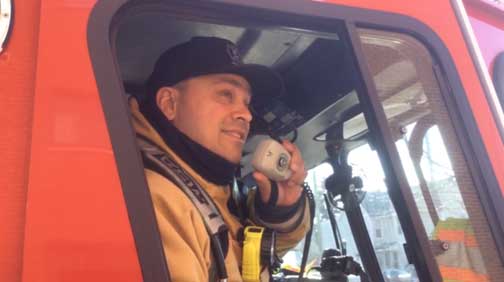
Once in the lobby, the officer must read the alarm panel to obtain additional information regarding the detection. At this time, he will transmit a second report via radio to the teams enroute so that they can be aware of what the alarm panel indicates.
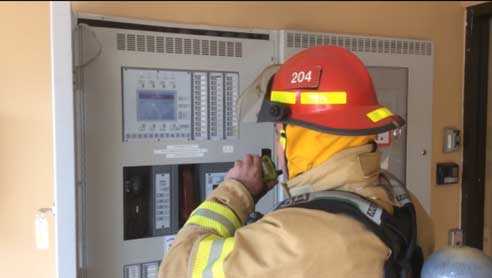
It is important to mention here that regardless of the presence of a manager or resident on the premises who provides information to us, we cannot skip this step. Although this is information that can prove useful and truthful, the officer must resist the trap of depriving himself of information from the alarm panel (young officers with limited experience may be especially susceptible of falling into this trap).
The third radio report will be broadcast upon arrival on the floor indicated by the alarm panel to clarify the situation and keep the responding teams informed.

Stairwells
While the officer proceeds to take information from the alarm panel, a first firefighter (firefighter #1) will take care of locating the stairwells, determining their identifications (letters or numbers), and whether there are standpipe risers inside. This information must be communicated to the officer. Picture #4
The elevator and access keys
The second firefighter who is part of the initial team (firefighter #2) will obtain the different keys giving access to the different sections of the building (via the person in charge or in the secure box outside) and will hand them over to the officer. The status of the elevators must be known. He may have to recall the elevator to prevent residents from being stuck there or for use by fire department personnel. Some elevator systems may have automatic recall when the alarms are triggered, but others don’t. This is also part of knowing our buildings.
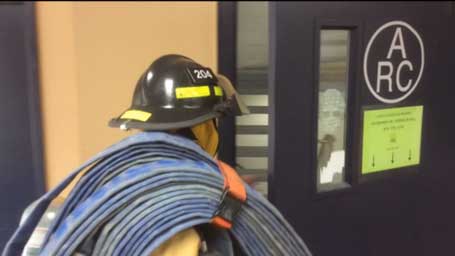
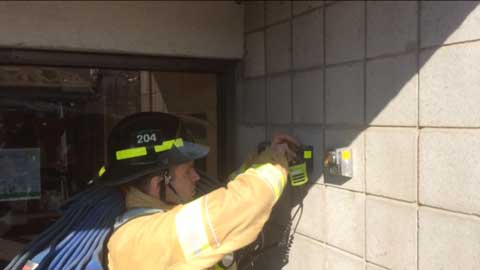
Inspection of siamese
Regardless of the type of incident in these new buildings, a proactive procedure can be put in place for each call to check the condition of the collectors (fire department connections) at the thread level, including intake swivel threads, possible obstructions inside or around them, and the appropriate signage in compliance with the regulations. This is accomplished by the operator while he is at his vehicle.
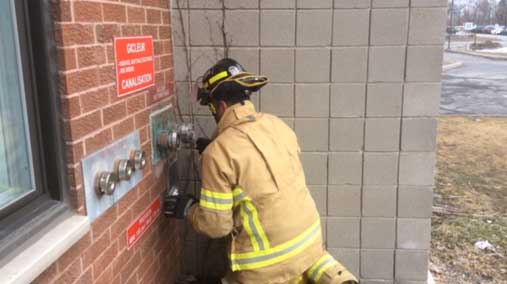
Whether it is the mid-rise, high-rise, or large buildings, never overlook a piece of equipment that may be often neglected—”the communication system” integrated into the alarm panel.

When I have used this equipment, I have been pleasantly surprised by its effectiveness, especially when many residents were waiting in the lobby. From the moment I broadcasted my message, total silence ensued and residents listened. After broadcasting our message, it is important to validate with our team doing the reconnaissance on the upper floor whether or not the message was heard where they are. If not, it may indicate that the system is not functional throughout the building.
Lesson Learned
In the summer of 2022, I had to respond in a high-rise building for an alarm activation on the seventh floor. Although not a “mid-rise,” the procedures listed above are required within our department from the first company on site. On that day, I had two acting officers who had less than a year of experience in the role of officer within the first two engines.
When the first team arrived, all the procedures were undertaken until the building manager arrived at the lobby and reported that smoke was escaping under the door of an apartment. As I got out of my chief’s truck, the officer contacted me regarding the situation. The officer mentioned on the radio the stairwell that would be used to access the floor concerned. It was at this point that I took command in the lobby and immediately transmitted a voice message to notify the residents of the situation. When the second crew arrived at the lobby, the other young officer, without hesitation, conducted the procedure which was intended to back up the first team. The fire was quickly contained in an orderly manner for the simple reason that basic procedures were conducted properly.
As battalion chief, I demanded rigor from my teams (which sometimes made me unpopular) in following basic SOPs. This incident made me very proud of my two young officers who were there. For small departments that may not have a lot of calls, having procedures that everyone can master can make an enormous difference in the smooth running of operations.
Complacency is the greatest enemy of firefighters and chief officers must be vigilant towards their lieutenants and captains so that the latter do not succumb to it.
As you can see above, these initials actions, which are not very exhaustive and which can be integrated into an operational procedure, can prove crucial to the smooth running of operations in the event of a confirmed fire.
It is essential that the officer apply these on each call, regardless of its nature. If we approach everything with a “bungalow” mentality or, worse, with complacency or a lack of SOPs, we run the risk of failure. These can chew through our resources very quickly, especially when there is a good fire condition and the building is occupied. Building an effective response matrix in your fire department will be beneficial for responses to these types of buildings.
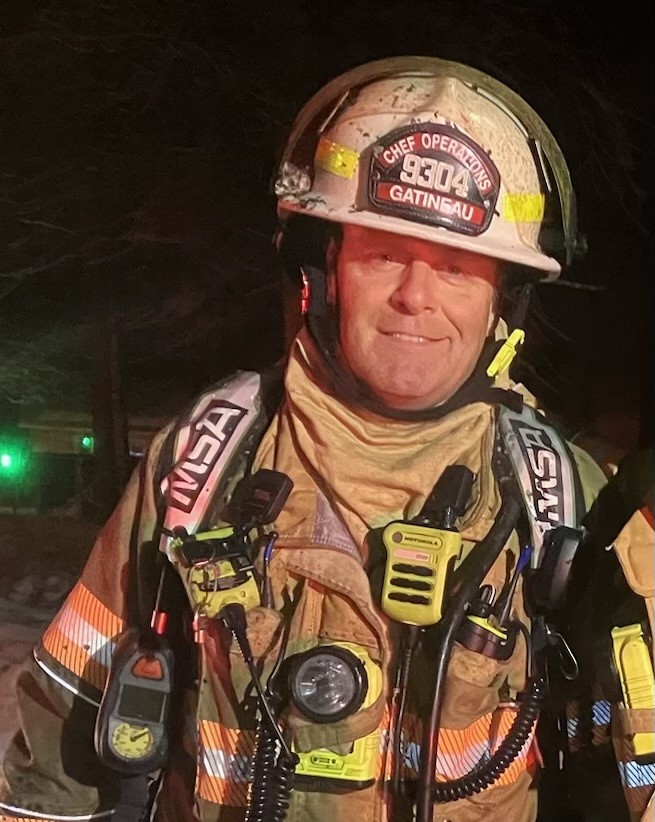
Alain Rancourt has 34 years in the fire service and is currently a battalion chief assigned to station 4 in the downtown area with the Gatineau Fire Department, Quebec Canada. He is also an instructor and speaker in fireground tactics and incident command for various fire departments, as well as for the Quebec fire chiefs convention. He’s has also participated in FDIC International for the past 15 years.

